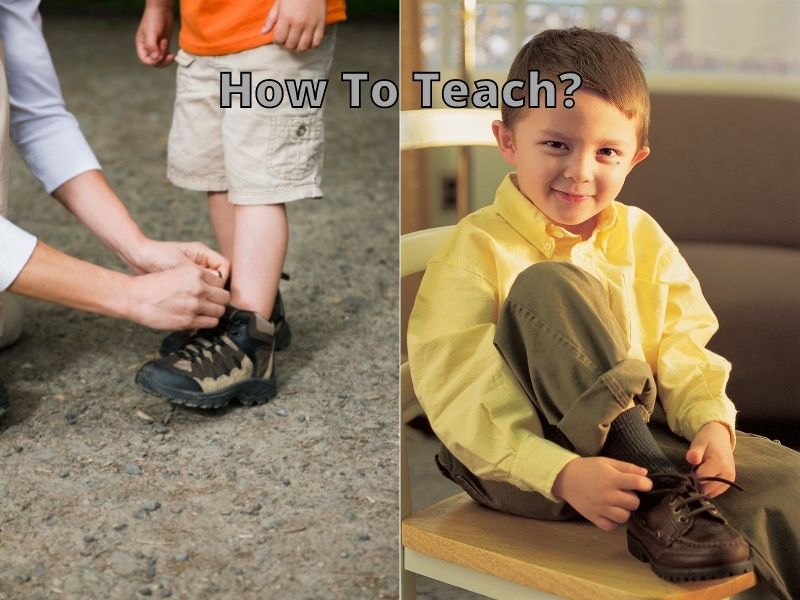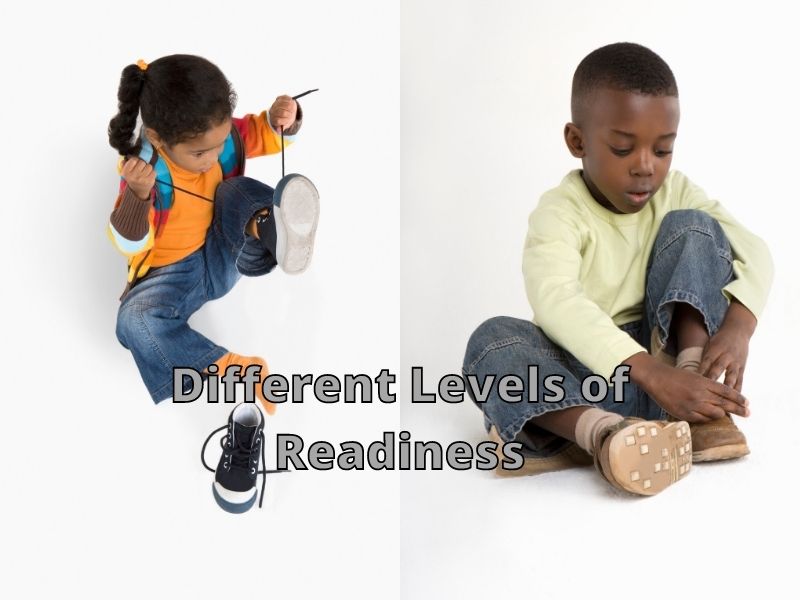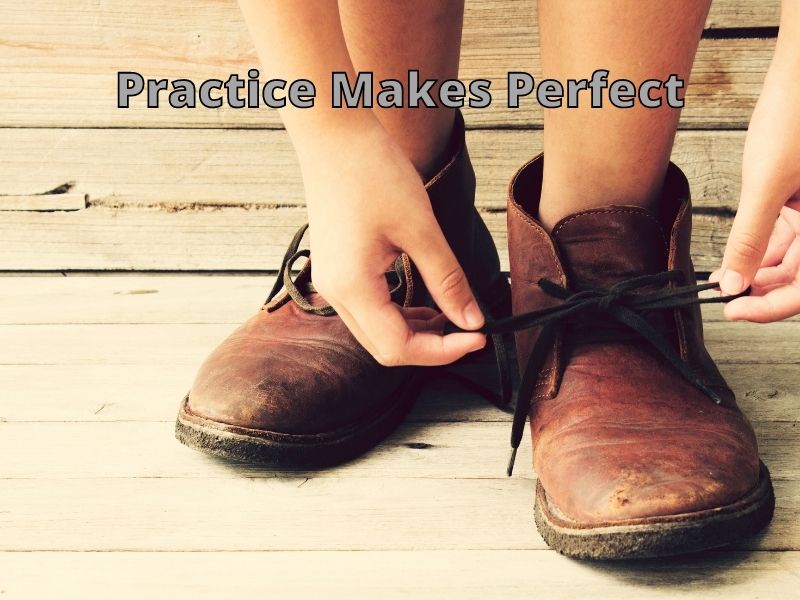No one can wear velcro shoes for the rest of their lives. Tying shoelaces is a necessary skill because it’s not just about shoes but also coordination. However, you might be wondering at what age should your child learn to tie their shoes?
Generally, your child should be at least five years old when they learn to tie their shoes. Children generally develop sufficient coordination and motor skills at the age of five to learn shoe tying. Although most kids learn to tie their shoes around five or six, they can start earlier or later. It depends on several factors like:
- Developmental delay
- Fine motor skills
- Different levels of readiness for girls and boys
Do not force your child to learn to tie shoelaces before the age of five, as it can be frustrating for both of you. Your child’s brain and fingers won’t be able to communicate and coordinate to successfully complete the task if he/she is not developmentally ready.
Do Children Need Finger Strength To Tie Shoes?
Children may not be able to learn how to tie their shoelaces until they are at least five years old since they have not yet developed fine motor finger movements or coordination. Muscles in the fingers need to be developed.
Learning to tie shoelaces is challenging for both children and their parents since it involves lots of practice, patience, and determination. Using playdough, silly putty, cutting paper, and coloring/drawing can help fingers gain dexterity.
Several tips (discussed in detail later), songs, and poems may help you teach your children how to tie their shoelaces. But, first, let’s talk about how to teach your children to tie their shoelaces.
How To Teach Your Children to Tie Their Shoelaces?

One of the most common and popular ways of tying shoelaces is the “Bunny ears method .”[ Different Ways To Tie Shoelaces]
However, every child learns at a different pace and in a different way. Therefore, I would recommend teaching them different methods for tying shoelaces so that they will learn whatever seems easiest to them.
Some children learn best with the shoe on their foot, while others learn best with the shoe in front of them. So you need to figure out which works better for your kid and proceed.
I recommend placing it in front of them or on a table because bending over to tie shoelaces is a challenge in itself.
Steps To Follow
- Basic knot: Sit behind your kid and hold their hands while guiding them. Hold each lace in their hand and thread one over the other, making a cross. Tuck the aglet of the upper lace through the hole. Pull them tight to form a knot.
- Make a bunny ear: Using the right lace, make a small loop like a bunny ear and hold it firmly in your child’s hand. Ensure the loop is held between your child’s thumb and the first two fingers.
- Make another bunny ear: Using the left lace, make another small loop on the right lace like a bunny ear and hold it firmly in your child’s hand. This loop is also held between your child’s thumb and the first two fingers.
- Bunny ears knot: Now, hold their hands to tie a knot with the bunny ear loops. Make an X with bunny ear loops by crossing the left and right loops. Then, thread the left loop through the hole.
- Tighten: Hold both bunny ear loops in your child’s hand and gently pull them to tighten the knot.
When Should Children Learn to Tie Their Shoes?
At least five years of age is an appropriate age to teach your child how to tie his or her shoelaces. By the age of five, children have developed enough coordination and motor skills so that they are ready to learn. When teaching your child to tie their shoelaces, I recommend getting thick shoelaces first to make the learning process easy.
Another good idea for making this process fun and easy is to get a shoebox for tying shoelaces. Your kid will love to learn. In addition, they will have a wider area to work with and will practice over it.
Examine Your Child’s Motor Skills

You need to examine your child’s motor skills before teaching them how to tie their shoelaces. Make sure your child has learned the fine motor skills necessary to succeed in the task. If they haven’t developed those skills, they won’t learn anything; rather, it will be a frustrating experience for them
Tying shoelaces requires the following fine motor skills:
- Hand strength
- The ability to interpret what is seen
- Good hand-eye coordination
- Using both hands in a coordinated manner
- Moving fingers independently
If your child lacks any of these skills due to their age or other developmental issues, tying shoelaces will be challenging. Therefore, before teaching them how to tie shoelaces, you need to work on these skills first. In this way, they won’t feel discouraged; they will learn quicker.
Girls And Boys Have Different Levels of Readiness

Boys and girls have different timings of readiness. They develop their motor skills at different ages. As each child is different from the other similarly, girls are different from boys in their learning and developmental skills. Their age of learning to tie their shoes or being ready to learn is separate from each other.
When I say by the age of five or six, children generally learn to tie their shoelaces, it is usually girls who are in this age group. On the other hand, boys are generally ready to learn to tie their shoelaces until they reach the age of eight. However, the age varies depending on the child and their abilities.
What If Your Child Cannot Tie Their Shoelaces?

Most kids learn to tie their shoelaces at the age of five or six, but that’s not always necessary. Due to delayed fine motor skills, some children may not be able to tie their shoelaces for quite a few years.
If your child can’t tie their shoelaces, you should look at their developmental skills and not just their age. Sometimes a child may have a developmental delay.
Many parents opt for shoes that need no tying. I often use elastic laces and slip-on shoes myself, and many children’s shoes also have velcro straps (Amazon Link).
In such cases, you don’t need to pressure your child; instead, examine their skills and watch their progress. For example, observe their fine motor skills, hand-eye coordination, and whether they can coordinate their hands to do a task.
If your kid is struggling with these skills, you need to consult a pediatrician to talk about your kid. They can help you build these skills at home and help your kid.
In recent years, many children struggle to tie their shoelaces and even learn how to do it at a later age. This is because they have so many alternatives like elastic laces or no tie shoes. Also, many parents are choosing other options instead of teaching their kids to tie their shoelaces.
If your child isn’t learning or struggling to get them to tie their shoes, it could mean they’re not ready for learning, or you’re probably not ready to teach them. So, relax, give yourself and your child some time, and make this a less stressful experience.
Why Is It Important to Teach Your Child How to Tie Shoelaces?

- Tying shoelaces is important not just because they will be able to tie their shoes but also for other reasons.
- Once your kid is five or six, you need to start teaching them how to tie their shoes. This task requires several motor skills, including hand-eye coordination and in-hand manipulation. In addition, it will allow you to determine whether your child is ready for more challenging tasks.
- It will help you understand your child’s skills, strengths, and weaknesses.
- It will give you an opportunity to understand if your child lacks something.
- Tying shoelaces require learning and remembering different steps. So it will help you build and enhance their skills like sequencing, focus and attention, and visual memory.
Shoe Tying Tips and Tricks to Help Your Child
Here are some tips and tricks to help your child learn how to tie their shoes.
Place Shoes on A Table
Learning how to tie shoelaces on shoes placed in front of them will make the learning process easier. Therefore, place their shoes in front of them or on a tabletop. Even though some children prefer to learn while wearing shoes, bending over to tie shoelaces can be challenging. So, figure out what works for your kid and proceed with that.
Use Your Shoes as A Sample
It can motivate your child to learn to tie shoelaces on your shoes. So, you can use your shoes as a sample. Furthermore, it makes learning easier since your shoes have longer and thicker laces than your kids’.
Use Different Colored Shoelaces
Using different colored shoelaces makes the learning process fun and easy. It will make it easier for you to explain each step and for your child to visually learn each step. Your child won’t get confused with right and left lace; instead, they’ll have to see and learn the colors.
Have Patience
It will take time. It is not an overnight process. I am sure you wouldn’t have mastered it in a day, so how can you expect your kid to?
Keep practicing on them, and they will eventually learn. Just don’t give up!
Use The Backward Chaining Method
Breaking down difficult tasks into smaller parts to teach children is called backward chaining.
You can use the backward changing technique to teach your kids to tie their shoelaces. In this way, you will have to do all the steps yourself and let your child do the last step and complete the task. Teaching your kid in a reverse manner gives your kid a sense of satisfaction and an experience of success and completion during the learning process.
Focus On Laces
Do not use short laces while teaching your child since they are difficult to manage. Also, short laces do not have enough room for your kid to handle them.
Avoid using round laces because they can easily get untied. Instead, use flat laces; they are easier to manage.
If your child has difficulty learning, use a wire ribbon since it can keep its shape better. Also, don’t buy your kids shoes with thin laces. Instead, choose thick-laced shoes since they will be easier for your kid to handle.
Add Dots to Shoelaces
Add a few dots to your child’s shoelaces. That will help them understand where to hold the lace. It will also help your child to make the perfect knot.
Clothespin
Use a clothespin to hold the shoelaces in place. Eventually, your kid will figure out how to do it independently, but it’s helpful to have an extra hand when they are just learning.
See If Your Child Is Left-Handed
To teach your child to tie their shoes, first determine whether they are left-handed or right-handed. If your child is left-handed, sit in front of them; if they are right-handed, sit behind them.
Practice Is a Must

Even if your child has learned to tie shoelaces, this activity requires time and practice. You need to help them practice, so they get used to it. Your child needs to develop patience and maturity along with motor skills.
At the age of five, your child has almost developed their motor skills. However, they still need to develop their ability to sit and tie their shoes.
If they don’t practice sitting and tying their shoelaces, they will certainly forget the process or might not be able to do so on their own.
Songs And Poems to Help Your Child Tie Their Shoes
Poems and songs play an integral part in educating your kids. Many songs and poems can help your child learn how to tie a perfect knot. They set the beat to sync the steps and motivate your children to learn.
Here are a few songs and poems that might help you and your kid:
Thanks for visiting helpshoe.com
References
https://www.moms.com/what-age-kids-able-tie-shoes/ (Update: Page no longer available)
carolinatherapyconnection.com (Update: Article not available)

